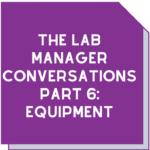The Lab Manager Conversations part three – Development
We’ve been speaking to lab managers and leaders about their roles and challenges. These conversations have been collated into a series of articles that will probably resonate not only with lab leaders, but those across other businesses as well.
While their pathways may have been somewhat different, all our respondents have clocked up well over 10 years of experience prior to their current roles. They also cover the spectrum of calibration, chemical, microbiology, electrical, inspection and environmental laboratories.
And although they were pleased to talk through their issues, by request we’ve changed their names to maintain confidentiality.
Staff development
 This topic was high on the list of activities for good lab managers.
This topic was high on the list of activities for good lab managers.
Of course, if your lab has NATA accreditation or certification with another body, your staff training records are something you’ll need to show during an assessment. These training records demonstrate where each staff member is up to in their learning and development and is evidence of an ongoing process.
Lauren sits down with her staff to work out a development plan. “This plan covers a 12-month period and it’s done from a business perspective,” she explains. “We talk about what the lab will need and things like role development. But we cover everything including technical, personal development and leadership skills”.
Everyone agrees that ‘soft’ skills and leadership skills are now being more widely offered. This has opened opportunities for staff members while also giving them greater understanding of the management role. As we touched on in the first article in our Lab Manager Conversations series, it’s important to remember that competence does not just include the technical skills necessary to do the job.
Individual motivation
Sarah has regular catch ups with her staff but is more supportive of those who come to her with a plan.
“I want them to actively show up and demonstrate that they want to improve,” she explains. “These are the people I’m pleased to mentor and recommend for a leadership role. I’ve had a staff member put their hand up to do a course and then two weeks later they mention nobody has contacted them. And my response is – what did you do? Who did you speak to? Did you even follow up? Because to me that would demonstrate commitment whereas waiting for something to drop in your lap doesn’t”.
She’s also a strong believer in self learning opportunities. “There are plenty of opportunities to learn online. Our company provides free access to LinkedIn learning but even YouTube videos can give you some great information!”
Matthew agrees: “People can get information from newsletters, industry publications and company websites. Reading the information on your suppliers’ website can be really useful. Even reading through an equipment manual can give you some insights!!”
Sometimes you can’t help
Chris noted that some people don’t want to learn and grow, and you simply can’t make them.
“There will always be people who just want to turn up, do their job and go home. However, the days when you were promoted because you were ‘next in line’ are long gone. Now there’s no line and staff members need to prove their value to the business. And when they realise that’s the case, well it can be a difficult conversation”.
What if your company is known for promoting internally but brings in someone from outside to fill a role in the lab?
This happened to Lauren: “It was such a problem because we had an employee who applied for a senior role in the lab and didn’t get it. Since she’d been with us for a few years, she assumed this was just a formality and she’d simply move up the chain. I’d spoken to her about improving her skills before she applied but she’d done nothing about this, done nothing to demonstrate she could step up into that more senior role. She was shocked that she didn’t get the promotion and even though I explained what she could do to improve her chances next time around, she ended up leaving”.
Successful training
 While everyone agreed that training staff was an important part of an efficient lab, there were several factors to consider.
While everyone agreed that training staff was an important part of an efficient lab, there were several factors to consider.
Sarah: “Choose your trainer wisely! Honestly, some people can do the job, but they just can’t train. You don’t just want people to follow the processes, you want them to understand the why and be able to troubleshoot as well”.
She added that external training was valuable. “External training helps because they bring new ideas back to the lab and that helps with efficiency. It can also help break their ‘this is the way we always do it so we can’t change it’ mentality,” she added.
Lisa noted that training isn’t a one-off activity. “You can’t just show them once and say off you go. You need to be sure they’re clear and comfortable. And follow up so they know you have their back.”
While Chris is happy to support additional learning, there’s something he wants from his staff first.
“Do your job. We don’t have a formal process for requesting additional learning. And if you show interest and desire, I’ll always help you. But first I want you to show me you can do your job effectively. And that’s not just about performing tasks. Are you applying your knowledge critically? Are you thinking about what you’re doing? If I see evidence of that, I’m more than happy to help you progress.”
All our Lab Managers recognise that improvement is not just a thing to do with the system. It comes down to a willingness of individuals to show not only do they have the technical skills to perform a task well, but lab improvement can also be a reflection on the type of people in the team and their appetite to improve personally.
So, when you’re in the cut and thrust of an accreditation or certification audit, don’t forget about these smaller improvements you’ve made to your lab ecosystem. It all counts.
Motivation
We’ve mentioned the time and cost involved in training new people so retaining employees makes good business sense. It’s also disruptive to the workings of the lab if there’s a revolving door of staff.
Naturally, people want to fair pay for their work and financial rewards are important. But this will only get them in the door, it won’t keep them.
If someone has just joined your team, Daniel believes it’s up to you to discover their stories. He tries to understand an individual’s background and motivations to get the best from them: “I use open, honest, planned discussions to facilitate this process. This way the person is more likely to buy in to any outcomes”.
He also likes to create a flexible working environment as much as possible such as staggered start and finish times. If the budget allows other incentives such as financial bonuses or gift cards can be offered. But regardless of the format, it’s the recognition of good work that’s important.
Ask them the question
 As a lab manager, understanding what motivates an individual is critical.
As a lab manager, understanding what motivates an individual is critical.
You need to know what they would see as a positive and would relish as a challenge. Sending someone to a conference to present a paper may sound like a positive to you but to an introvert it could be their idea of hell!
Depending on the type of lab, extras or incentives may not be available. Semi government labs for example may be limited to offering flex time. But that means more creative solutions can be explored.
“It doesn’t have to be financial,” says Daniel. “It could be a company wide recognition programs, peer, or team programs. Public recognition is valued and valuable because everyone likes to be told they’re doing a good job. Have a BBQ or similar get together to celebrate wins. This also allows for a different type of interaction. When was the last time you lined up for a sausage on a roll with the CEO? Or even better, stood next to them while you were both on BBQ duty!”
Chris believes that the work itself can be motivating. “In my lab, our work is aimed at helping people. The job you’re doing is meaningful and assisting others. That may not be enough for everyone, but it’s definitely a factor here.”
He also offers a different kind of financial incentive: “I tell people that if you see an opportunity, do the work, and develop a new test to solve a problem, I’ll give you a percentage of the profit from that test. So how motivated are you to do that work? Very few people are.”
Keep them interested
Hopefully everyone has one thing about their role that makes them excited about coming to work. The only way to find out what motivates them to do a good job is to ask. This is particularly the case for high achieving staff members.
Lisa: “Being able to recognise people that have a lot of potential is a benefit for them and for the business. Don’t let them get frustrated. Offer to mentor them. Talk about their goals and expectations. Demonstrate how they can work their way up through the organisation. These are the people you want to have as part of your succession planning and growth.”
Despite your best efforts, sometimes good staff will think the grass looks greener on the other side. Chris says you have to let them go, but…
“One of my excellent staff members left for another lab and yes of course that happens. But after a few months of clock watching, dreary work and filling out time sheets, she came back. That grass wasn’t so green after all!”
Next week we’ll talk about communication and handling conflict.
Download the article The Lab Manager Conversations part three – Development




